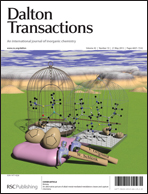Two novel bimetallic borohydrides, Rb[Y(BH4)4] and Cs[Y(BH4)4], have been synthesised via mechanochemical reactions between MBH4, M = Rb or Cs and Y(BH4)3. Both are ionic compounds comprising complex anions [Y(BH4)4]− and alkali metal cations, and they adopt crystal structures which were not observed previously for quasi-ternary borohydrides. LiCl, a by-product from the synthesis of Y(BH4)3, is not an unreactive dead-weight but rather it promotes formation of trimetallic borohydride-chlorides, M2Li[Y(BH4)6−xClx], which crystallise in the elpasolite-type structures. Formation of Cs2Li[Y(BH4)6−xClx] takes place during the mechanochemical synthesis of Cs[Y(BH4)4] at room temperature, while that of Rb2Li[Y(BH4)6−xClx] only after heating of the sample above the melting point. The M[Y(BH4)4]/M2Li[Y(BH4)6−xClx] mixtures slowly release H2 when melted (Tm = 170 °C for M = Rb, 210 °C for M = Cs) but the main stage of thermal decomposition occurs at a Tdec of ∼270 °C, similarly to what is observed for K[Y(BH4)4] and NaBH4/Y(BH4)3 composites. We also demonstrate how the Tdec of M[Y(BH4)4] salts may be tuned by choosing the MBH4 precursor of the appropriate Lewis basicity.
![Graphical abstract: M[Y(BH4)4] and M2Li[Y(BH4)6−xClx] (M = Rb, Cs): new borohydride derivatives of yttrium and their hydrogen storage properties](/en/Image/Get?imageInfo.ImageType=GA&imageInfo.ImageIdentifier.ManuscriptID=C3DT33048F&imageInfo.ImageIdentifier.Year=2013)
You have access to this article
 Please wait while we load your content...
Something went wrong. Try again?
Please wait while we load your content...
Something went wrong. Try again?
![Graphical abstract: M[Y(BH4)4] and M2Li[Y(BH4)6−xClx] (M = Rb, Cs): new borohydride derivatives of yttrium and their hydrogen storage properties](/en/Image/Get?imageInfo.ImageType=GA&imageInfo.ImageIdentifier.ManuscriptID=C3DT33048F&imageInfo.ImageIdentifier.Year=2013)

 Please wait while we load your content...
Please wait while we load your content...